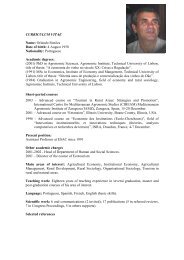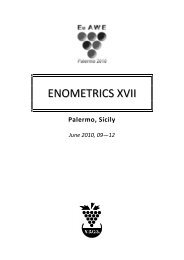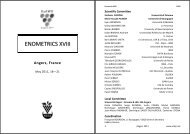Daniel Steichen* *IUT de l
Daniel Steichen* *IUT de l
Daniel Steichen* *IUT de l
You also want an ePaper? Increase the reach of your titles
YUMPU automatically turns print PDFs into web optimized ePapers that Google loves.
How taste and reputation affect the champagne market<br />
January 2005<br />
Christophe Terrien* – <strong>Daniel</strong> <strong>Steichen*</strong><br />
*I.U.T. <strong>de</strong> l’Aisne, 2 place Pierre Curie, 02000 LAON<br />
*Université <strong>de</strong> Reims Champagne-Ar<strong>de</strong>nne<br />
EA 2065, Laboratoire OMI-EDJ,<br />
christophe.terrien@u-picardie.fr<br />
daniel.steichen@u-picardie.fr<br />
Key words: dynamic mo<strong>de</strong>l, vertical differentiation, myopia parameter, champagne<br />
wines, taste, target quality, consumer behaviour, quality, goodwill<br />
ABSTRACT<br />
This paper presents a dynamic mo<strong>de</strong>l of sales on the champagne wine market. It<br />
is assumed that goods are vertically differentiated on this market with the result that, for<br />
a given price, there is a generally accepted rank or<strong>de</strong>r.<br />
Three categories of actors operate on this market. Wine merchants are few in<br />
number but propose large volumes of a high-quality product they alone can provi<strong>de</strong>.<br />
Wine growers are numerous, each proposing a small quantity (compared to merchants)<br />
of a low-quality product they alone can provi<strong>de</strong>. Buyers are <strong>de</strong>fined by the income<br />
available to them to purchase champagne and by their own individual target quality.<br />
This target quality (individual taste for product of a given quality) can be interpreted as<br />
a personal (not shared) preference relation based on qualities observed on the market<br />
and on the purchaser’s consumer habits. The importance of this behaviour is modulated<br />
by what is termed here a ‘myopia parameter’.<br />
The consumer’s choice (to buy or not to buy) <strong>de</strong>pends on the surplus <strong>de</strong>rived<br />
from four factors: product quality, product price, willingness to pay and target quality.<br />
These factors are modulated by the vertical differentiation parameter and the myopia<br />
parameter.<br />
The mo<strong>de</strong>l is ma<strong>de</strong> dynamic by having the actors make adjustments over time.<br />
As bargaining advances, buyers adjust their target quality while sellers adjust their price<br />
<strong>de</strong>pending on previous sales.<br />
Various simulations were carried out based on different pairings of the myopia<br />
and differentiation parameters. The results show that excessive product differentiation<br />
combined with a weak myopia parameter make the market unstable.<br />
- 1 -
1. Introduction<br />
Our mo<strong>de</strong>l is original in that it provi<strong>de</strong>s a form of consumer interpretation of<br />
uncertainty about quality on the champagne wine market. Because of the problems<br />
individuals have in appraising the product’s characteristics, they measure quality on the<br />
basis of a signal which is a matter of common knowledge such as a particular<br />
champagne’s reputation. Their initial choices are based on this signal. Repeated<br />
experience then allows individuals to make their own judgements about the product,<br />
which then relativises their faith in its reputation.<br />
1.1 Observable and non-observable quality<br />
Quality is regar<strong>de</strong>d here as the economic variable that <strong>de</strong>termines how the<br />
market operates, alongsi<strong>de</strong> price and income (Stiglitz 1987), in particular with regard to<br />
its non-observable content. If, at the time of exchange, the price is visible, we consi<strong>de</strong>r,<br />
following Arrow (1963) and Akerlof (1970), that consumers have insufficient<br />
information about this product in contrast to the omniscient seller. Champagne can be<br />
consi<strong>de</strong>red a heterogeneous good with a multitu<strong>de</strong> of characteristics relating to research<br />
(Nelson, 1970), experience (Nelson 1970), and belief (Darby and Karni, 1973). Perfect<br />
knowledge of the product is compromised by limited rationality.<br />
These various categories of characteristics can be observed to a greater or lesser<br />
extent. The A.O.C, for example, as a guarantee of product characteristics is, a priori,<br />
fully observable. It relates to objective, measurable characteristics and is guaranteed by<br />
a trustworthy third party — government. However, the effectiveness of this signal is<br />
attenuated by the complexity of its content 1 which is accessible only in part because of<br />
the consumer’s limited rationality. 2 Accordingly the A.O.C is interpreted as a<br />
characteristic of belief. Lastly, the A.O.C, as a common frame of reference for<br />
producers, forces them to differentiate their products in terms of non-observable<br />
characteristics guaranteed by a brand name.<br />
Having product characteristics or guarantees that are unobservable raises a<br />
problem of moral hazard, because the producer may take advantage of the consumer’s<br />
ignorance of how reliable the product is (Cooper and Ross 1985). In addition, as<br />
Spence (1977) emphasises, consumers may be misled by there being a guarantee, as<br />
mentioned for the A.O.C. guarantee. Spence assumes consumers systematically<br />
overestimate the probability that a product is reliable. Producers who anticipate<br />
rationally can then make a profit by offering a weaker guarantee at a lower price.<br />
1<br />
2<br />
The A.O.C. is extremely complex for the uninitiated, involving characteristics of grape variety,<br />
cliping, yield, etc.<br />
According to a survey by Sylvan<strong>de</strong>r (1995), consumers associated ‘label rouge’ chicken with<br />
farmhouse or free-range chicken. Yet such farming characteristics are not inclu<strong>de</strong>d in the ‘label rouge’<br />
specifications.<br />
- 2 -
1.2. Reputation and its limits<br />
Because it is unobservable or inaccessible (there being such a mass of it),<br />
information generates excessive access costs for individuals. Consumers then seek<br />
synthetic guarantee signals either from in<strong>de</strong>pen<strong>de</strong>nt third parties (INAO for A.O.Cs) or<br />
from interested parties (branding), which are far less expensive as it is government or<br />
the seller who foot the bill. Reputation, 3 as a system of guarantee based on common<br />
knowledge 4 and shared values about a product, an individual or a firm, serves this<br />
purpose. However, it has been seen that these guarantees may involve varying <strong>de</strong>grees<br />
of moral hazard. This more or less strong feeling of moral hazard is reflected by the<br />
consumer’s varying level of confi<strong>de</strong>nce 5 in the guarantee given, which may <strong>de</strong>pend on<br />
the type of institution un<strong>de</strong>rwriting it or on sellers fulfilling their commitments. 6<br />
Fulfilment of commitments and so a reliable reputation are tested by past<br />
experiences of consumption. 7 The relative trust in reputation <strong>de</strong>pends on the gap<br />
between the consumer’s personal judgement, which is in turn built up through positive<br />
and negative confrontations with products, and the values bestowed on products through<br />
reputation. If consumers have faith in the self-reinforcing quality process, they expect<br />
firms to maintain their reputation and this is just what firms do. A balanced reputation is<br />
obtained corresponding to sustained product quality over time, thus meeting consumers’<br />
expectations.<br />
In reputation mo<strong>de</strong>ls, 8 the firm will be forced to provi<strong>de</strong> high quality if<br />
purchasers learn the quality of goods rapidly enough (this is the role of reputation as a<br />
synthetic signal) and if repeat purchases are ma<strong>de</strong> often enough. 9 In our mo<strong>de</strong>l stability<br />
is only achieved after a large number of purchase confrontations.<br />
3<br />
4<br />
5<br />
6<br />
7<br />
8<br />
9<br />
This may also be <strong>de</strong>fined as the goodwill value attributed to a firm (Shapiro, 1983, p. 659).<br />
For reputation to act as a signal it must be common knowledge (Shapiro, 1983, p. 663).<br />
We argue that relative trust varies with the discrepancy between the consumer’s own judgement and<br />
the credit affor<strong>de</strong>d to the brand by its reputation. See below.<br />
Furubotn and Richter (1997) claim reputation forges a self-reinforcing agreement about product<br />
quality. This agreement presupposes that government or other third parties cannot <strong>de</strong>termine whether<br />
or not the agreement has been observed and cannot check whether agents have met their<br />
commitments. It is the parties involved who judge whether commitments have been met, which is<br />
reinforced by the explicit or implicit threat of breaking off the contract (Telser 1980).<br />
Shapiro (1983) and Klein and Leffler (1981) show that reputation acts as an incentive for sellers to act<br />
honestly. At each period, a firm can change the quality of the good, but the consumer at time t knows<br />
the quality of the product at time t-1. If purchases are repeated (infinite horizon), consumers can base<br />
their estimates of quality on the firm’s reputation. The quality of goods produced by the firm in the<br />
past is used as an indicator of present and future quality.<br />
Kreps and Wilson (1982) and Milgrom and Roberts ,<br />
Tirole (1993) p. 224.<br />
- 3 -
2. The simulation mo<strong>de</strong>l<br />
2.1. Initial conditions<br />
2.1.1. Sellers<br />
We consi<strong>de</strong>r the champagne market comprises two main suppliers, wine<br />
merchants and wine growers. In this mo<strong>de</strong>l the number of sellers does not vary. There is<br />
no way out of the market even if sales are poor. The characteristics of merchants vary<br />
from those of growers. Merchants own reputed brands. This does not mean growers do<br />
not use brands but that theirs are not as well known and are not crucial sales factors.<br />
There are few merchants compared with growers. Wine merchants represent about 87%<br />
of all shipments and the leading six groups have more than 60% of the total sales.<br />
Consequently merchants’ production volumes are high. There is also a marked contrast<br />
in prices with a ratio of 2 to 1 between merchants and growers. This can be attributed to<br />
reputation. High spending on communication in brand capital implies high sales prices<br />
(reputation cost 10 ), which consumers associate with higher quality. Merchants have<br />
greater capacities for blending wines purchased from growers and it is the blending that<br />
confers (stable) taste characteristics on the product.<br />
The characteristics of merchants and growers are summarised below (Table 1).<br />
Table 1<br />
Number Sales potential Reputation Price<br />
Merchants Low High High High<br />
Growers High Low Low Low<br />
In the mo<strong>de</strong>l<br />
Ng is the number of growers<br />
Nm is the number of merchants<br />
These parameters are set in line with the relative numerical importance of each category<br />
of seller.<br />
Qmaxg: Growers’ maximum sales potential in units.<br />
Qmaxm: Merchants’ maximum sales potential in units.<br />
Km: merchants’ reputation in<strong>de</strong>x consi<strong>de</strong>red as common knowledge<br />
Kg: growers’ reputation in<strong>de</strong>x consi<strong>de</strong>red as common knowledge<br />
10<br />
Shapiro specifies un<strong>de</strong>r what circumstances reputation is an incentive for firms. Firms must enjoy<br />
higher takings than they would by lowering quality. Reputation for high quality entails a cost through<br />
the production of a quality good. This investment in reputation is recouped at equilibrium: high<br />
quality goods are sold for more than they cost to produce. This price difference corresponds to income<br />
from the investment in reputation (Shapiro, 1983, p. 660). The premium must be high enough for the<br />
cost associated with the loss of future sales to exceed current cost savings from a reduction in quality<br />
(Tirole, 1993). Without quality premiums firms would be tempted to increase their short term profits<br />
by lowering their product quality (Klein and Leffler, 1981).<br />
- 4 -
For the sake of simplicity, each seller proposes a single product associated with<br />
a certain reputation. The range of reputations equals the number of suppliers.<br />
Reputations are distributed randomly between a minimum and an intermediate value for<br />
growers and an intermediate and a maximum value for merchants. To maintain a<br />
quality-price relation that is consistent with our assumptions and with the real world,<br />
prices are distributed in the same way. Reputation brings about vertical differentiation<br />
among products so that, other things (income, price, etc.) being equal, a bottle of high<br />
repute is unanimously preferred to a bottle of mediocre repute.<br />
A product can be now i<strong>de</strong>ntified by 6 parameters in the mo<strong>de</strong>l (Table 2).<br />
Table 2<br />
In<strong>de</strong>x Description Example Type*<br />
1 Bottle number corresponding to a {9,0.462205,30,0.45138,0,5} P<br />
producer (each producer<br />
proposing a unique product)<br />
2 Reputation associated with the {9,0.462205,30,0.45138,0,5} P<br />
product<br />
3 Maximum quantity associated {9,0.462205,30,0.45138,0,5} P<br />
with producer<br />
4 Price associated with product. {9,0.462205,30,0.45138,0,5} V<br />
This price changes with the sales<br />
results of each cycle, that is<br />
when the last consumer has ma<strong>de</strong><br />
his choice.<br />
5 Flag: 0 = no purchase<br />
{9,0.462205,30,0.45138,0,5} P<br />
1 = purchase<br />
6 Aggregate sales for this product. {9,0.462205,30,0.45138,0,5} V<br />
* P = parameter (fixed, static). V = variable (dynamic).<br />
- 5 -
2.1.2. Buyers<br />
2.1.2.1. Characteristics<br />
Buyers characteristics are summarised below:<br />
Table 3<br />
In<strong>de</strong>x Description Example Type*<br />
1 Buyer i<strong>de</strong>ntifier {362,1.60112,0.536961,1,51} P<br />
2 Income associated with {362,1.60112,0.536961,1,51} P<br />
buyer<br />
3 Taste for product<br />
{362,1.60112,0.536961,1,51} V<br />
associated with buyer<br />
4 Flag : 0 = no purchase {362,1.60112,0.536961,1,51} P<br />
1 = purchase<br />
5 Aggregate purchases {362,1.60112,0.536961,1,51} V<br />
As for the distribution of prices and reputations, consumer incomes and tastes<br />
are distributed uniformly between a minimum and maximum value.<br />
In the mo<strong>de</strong>l<br />
Rmax is a buyer’s maximum income; R Є [0, Rmax]<br />
θmax is a buyer’s maximum taste; θ Є [0, θmax]<br />
Taste (θ):<br />
‘Taste’, in the mo<strong>de</strong>l, means a given consumer’s personal predisposition to purchase a<br />
given product. It can also be interpreted as a personal evaluation of a product’s<br />
reputation formed through experience, habit and the level of individual trust in<br />
reputation as mentioned before.<br />
2.1.2.2. Surplus function<br />
In our mo<strong>de</strong>l, buyers seek to maximise their satisfaction by choosing the bottle<br />
that brings them the greatest available surplus. Several criteria <strong>de</strong>scribe the purchasing<br />
process:<br />
‣ budget constraint is taken into account by the relation between income and price,<br />
‣ reputation k;<br />
‣ <strong>de</strong>viation between the common appreciation of quality through reputation and<br />
the personal appreciation of quality summarised by the taste variable;<br />
- 6 -
The consumer’s utility corresponds to the surplus S(R,p,k,θ)<br />
S (R, p, k, θ ) =<br />
R<br />
p<br />
*( Γ(<br />
k,<br />
θ ))<br />
α<br />
−1<br />
Where:<br />
k<br />
Γ ( k,<br />
θ ) =<br />
2<br />
(1 + ( θ − k)<br />
)<br />
β<br />
Γ ( k,<br />
θ ) is the quality of a bottle of reputation k (0 ≤ k ≤ 1) perceived by a consumer<br />
with taste θ (0 ≤ θ ≤ 1).<br />
R is income, (in the mo<strong>de</strong>l 0 ≤ R ≤ 2),<br />
p is the price of the product,<br />
k is reputation (0 ≤ k ≤ 1),<br />
θ is the consumer’s personal taste for champagne ( 0 ≤ θ ≤ 1),<br />
α is a parameter for modulating the budget constraint ( p<br />
R ) relative to quality perceived<br />
in the surplus function,<br />
β is a parameter for modulating the impact of taste relative to reputation in the<br />
perceived quality function ( Г(k ,θ) ).<br />
A purchase is ma<strong>de</strong> if S ≥ 0.<br />
The diagram below (Fig. 1) <strong>de</strong>picts the influence of β on reputation for a given θ<br />
(θ=0.5). Г(k ,θ) is <strong>de</strong>fined as the quality actually perceived by the consumer taking<br />
account of his personal allowance for reputation.<br />
Perceived quality Г(θ,k)<br />
1<br />
0.8<br />
Fig. 1<br />
k<br />
Γ(<br />
k,<br />
θ ) =<br />
2<br />
(1 + ( θ − k)<br />
)<br />
β<br />
β=0<br />
β=1<br />
0.6<br />
0.4<br />
0.2<br />
β=5<br />
β=10<br />
0.2 0.4 0.6 0.8 1<br />
k<br />
A high β expresses a high personal relativisation of reputation. Consumers have<br />
a distorted picture of high quality and have difficulty in clearly observing products<br />
remote from their own taste, hence the term ‘myopia’ parameter. These conclusions are<br />
found in Figure 2 which takes up the distortion of reputation for a high β but for<br />
different values of θ representing low, medium and high factors of personal taste.<br />
- 7 -
Г(θ,k)<br />
1<br />
0.8<br />
β=10<br />
θ=0,9<br />
0.6<br />
0.4<br />
θ=0,5<br />
0.2<br />
θ=0,1<br />
0.2 0.4 0.6 0.8 1<br />
k<br />
Notice that consumers with high taste levels appreciate highly-reputed products<br />
more. Conversely, they un<strong>de</strong>restimate products with poor reputations.<br />
2. Dynamics of the mo<strong>de</strong>l<br />
2.2.1. Changes in sale price<br />
It is assumed that suppliers aim to improve their turnover relative to the previous<br />
period. Remember a period ends when every consumer has ma<strong>de</strong> his choice (to buy or<br />
not to buy). At this point, each supplier knows the quantities sold. Each supplier has to<br />
estimate the sales trend from the previous period and the one just en<strong>de</strong>d. Suppliers’<br />
memory is therefore limited to two periods. Suppose that p 0 and q 0 are respectively the<br />
price and quantity of sales (in bottles) for the preceding period and p 1 and q 1 the price<br />
and quantity sold for the period just en<strong>de</strong>d. Let us consi<strong>de</strong>r that the other agents (sellers<br />
and buyers alike) change nothing. Each supplier may <strong>de</strong>ci<strong>de</strong> either to maintain his<br />
earlier <strong>de</strong>cision to raise or lower prices (<strong>de</strong>pending on the trend) or to revise that<br />
<strong>de</strong>cision. Any of the following situations may therefore arise.<br />
‣ S1: A price increase has brought about a rise in turnover. In this event, the seller<br />
maintains the strategy of price increases. The size of the increase is controlled<br />
by a random variable <strong>de</strong>termined from a given standard <strong>de</strong>viation σ and a mean<br />
µ.<br />
‣ S2: After a price reduction, if turnover increases, the seller continues to lower<br />
prices (controlled to some extent by the parameters of the random variable).<br />
‣ S3: After a price rise entailing a fall in sales, the seller changes strategy and<br />
cuts 11 prices in the next period.<br />
‣ S4: After a price fall entailing a fall in turnover the seller changes strategy and<br />
raises 12 prices.<br />
‣ S5: If turnover is stable from one period to the next, chance introduces a rise or<br />
fall in prices the size of which is set by the random variable.<br />
11<br />
12<br />
The size of the cut is set so as not to stay the same si<strong>de</strong> of p 0<br />
The size of the rise is set so as not to go beyond p 0<br />
- 8 -
‣ S6: This special situation arises at the beginning of the simulation when both q 1<br />
and q 0 are zero (no sales yet). The seller opts for a random price cut.<br />
As a final point, a price floor is allowed for, corresponding to production cost. It<br />
is assumed that no seller will accept to sell at a loss. This provision also preclu<strong>de</strong>s any<br />
collapse of the market.<br />
2.2.2. Changes in buyer’s taste<br />
Consumer expectations change with the results of the latest market confrontation<br />
(purchase or non-purchase). Should the bottle meet expectations, the purchaser moves<br />
closer to the expected quality. In this way allowance can be ma<strong>de</strong> for the buyer’s<br />
experience.<br />
δ ( k −θ<br />
0<br />
)<br />
θ1<br />
= θ<br />
0<br />
+<br />
1+<br />
( k −θ<br />
)<br />
The parameter “δ” is used to weight the rate of change in taste. We set δ = 1/5.<br />
The higher parameter δ , the more readily the consumer changes his taste.<br />
2.3. General operation of the simulation<br />
The standard starting factors of the mo<strong>de</strong>l are supply represented by two agents<br />
(growers and merchants) and <strong>de</strong>mand represented by purchasers. A cycle is completed<br />
when all the individuals making up the <strong>de</strong>mand si<strong>de</strong>, characterised by their own income<br />
and their own taste, etc., have managed to choose from the available supply of bottles<br />
proposed by growers and <strong>de</strong>alers. Each buyer has full information about the supply,<br />
particularly about the full set of prices and reputations.<br />
During a cycle, a buyer is taken at random and chooses from the available<br />
supply the product giving him the greatest positive surplus. If no bottle provi<strong>de</strong>s a<br />
positive surplus, then no purchase is ma<strong>de</strong>. Otherwise, a purchase is recor<strong>de</strong>d by<br />
<strong>de</strong>ducting the chosen bottle from the relevant seller’s available stock of products<br />
Another purchaser is chosen at random and the process is reiterated. The cycle ends<br />
when the last buyer has ma<strong>de</strong> a <strong>de</strong>cision. There are as many supply-<strong>de</strong>mand<br />
confrontations as there are buyers. 13 At the end of the cycle just set out, sellers adjust<br />
their prices in line with sales which <strong>de</strong>termine a trend in relation to the previous cycle.<br />
At the same time, buyers may adjust their taste <strong>de</strong>pending on the purchase ma<strong>de</strong>.<br />
Consequently, there are three stages in the operation. The first is to draw up a table of<br />
buyers and bottles (or sellers since a seller produces only one type of product, which is<br />
an acceptable simplification in the case of champagne). Each product’s reputation<br />
remains constant. 14 The second stage is an initial supply-<strong>de</strong>mand confrontation whose<br />
0<br />
2<br />
13<br />
14<br />
For the simulation the number of purchasers is greater than the number of sellers. There is, in fact, a<br />
chronic <strong>de</strong>ficit of supply on the champagne market.<br />
Again this matches the historical reality of the champagne market. The reputation of the great<br />
champagne houses has been sustained since they were formed in the 18th and 19th centuries (Henriot<br />
1808, Perrier-Jouët 1811, Laurent Perrier 1812, Mumm 1827, Bollinger 1829). Cuvée Dom Pérignon<br />
dates from 1921. Packaging is i<strong>de</strong>ntical to Cuvée du centenaire from Simon Brothers, Moët’s UK<br />
brokers. Until 1947, cuvée Dom Pérignon was reserved for the UK. Moët et Chandon work to<br />
maintain its reputation. The brand was served at royal weddings. Edward VII in 1902 with the 1898<br />
year, when Prince Rainier acce<strong>de</strong>d in 1949, at his wedding in 1956, at the wedding of King Baudouin<br />
in 1967.<br />
- 9 -
outcome influences the purchaser’s taste. However, sellers cannot yet change their<br />
prices as two results are nee<strong>de</strong>d to i<strong>de</strong>ntify a trend. This problem is solved at the third<br />
stage illustrated by a second confrontation changing tastes and prices. The first two<br />
stages are all that is nee<strong>de</strong>d to start the simulation. The iterations bring about the third<br />
stage. In our mo<strong>de</strong>l, the buyer is in a purchase situation one thousand times.<br />
3. Results<br />
Calculations were ma<strong>de</strong> with the following parameters:<br />
Number of cycles = 1000<br />
To allow for disruption in the starting conditions, the first 200 cycles were ignored.<br />
Tests were also ma<strong>de</strong> on a very large number of cycles without radical differences in<br />
results.<br />
Price floor = 0.1<br />
Ng = 20<br />
Qmaxg = 25<br />
Ng = 5<br />
Qmaxg = 400<br />
Na = 5000 (buyers number)<br />
These parameters are set in line with the real situation on the champagne market,<br />
particularly the representative character of categories of sellers and their market shares.<br />
Buyer’s taste = 3/4<br />
Income: max. = 2<br />
δ=1/5 (weighting for rate of change of taste)<br />
3.1. Results removing the effects of reputation and taste (α = 0 , β = 0 , δ = 0)<br />
Fig. 3<br />
Total quantities sold (Growers and merchants)<br />
600<br />
500<br />
400<br />
300<br />
200<br />
100<br />
Q vendues neg+vig<br />
200 400 600 800 1000<br />
Figure 3 shows the change in total quantities sold over time eliminating the<br />
influence of reputation and taste on consumer choice (α = 0 , β = 0 , δ = 0). Values<br />
change in a ratio of 1 to 6. The market is highly unstable, swinging between extremely<br />
profitable situations and situations of virtually no sales. The market does not seem to<br />
operate without signals for reducing uncertainty about quality.<br />
- 10 -
3.2. Results influenced by reputation and taste (α ≠ 0 and β ≠ 0)<br />
All other parameters are unchanged. The market is i<strong>de</strong>ntical to the previous one.<br />
The distribution of buyers (income, taste, etc.) and suppliers (initial price, reputation,<br />
etc.) is i<strong>de</strong>ntical.<br />
Compared with the results of Figure 3, the market is very stable as can be seen<br />
from Figure 4 showing the change in sales by growers over 10,000 cycles (for α=1 and<br />
β=5)<br />
360<br />
Fig. 4<br />
Grower’s sales<br />
Q vendues vig<br />
350<br />
340<br />
330<br />
320<br />
310<br />
2000 4000 6000 8000 10000<br />
Fig. 5<br />
Merchant’s sales<br />
Q vendues neg<br />
1500<br />
1400<br />
1300<br />
1200<br />
1100<br />
1000<br />
2000 4000 6000 8000 10000<br />
The same stability is observed for quantities sold by merchants. The range over<br />
which sales change is much more limited (10–50%). In accordance with the starting<br />
equations, consumer taste changes markedly upmarket (Fig. 6). Prices change little (Fig.<br />
7).<br />
- 11 -
Fig. 6<br />
Average taste evolution<br />
Evol. gout moyen <strong>de</strong> la population<br />
0.525<br />
0.52<br />
0.515<br />
0.51<br />
0.505<br />
2000 4000 6000 8000 10000<br />
Fig. 7<br />
Growers’ average price<br />
Prix moy. marché vig.<br />
0.62<br />
0.61<br />
0.59<br />
2000 4000 6000 8000 10000<br />
0.58<br />
0.57<br />
0.56<br />
Fig. 8<br />
Merchants’ average price<br />
Prix moy. neg.<br />
1.3<br />
1.2<br />
1.1<br />
2000 4000 6000 8000 10000<br />
Merchants’ average price is consistent with the change in sales. As the results as<br />
a whole are consistent, we examined the effects of different values of α and β on market<br />
stability. It can be seen that when α increases, stability, expressed by the variation<br />
coefficient, <strong>de</strong>creases.<br />
- 12 -
3.3. Impacts of qualitative interpretation on the market<br />
Two snapshots of the market <strong>de</strong>pict the impact of the consumers’ interpretation<br />
of quality. Figure 9 shows consumers’ positive surpluses in the initial state.<br />
Computations are therefore ma<strong>de</strong> from tables of consumers and initial products. Figure<br />
10 shows consumers’ positive surpluses at the end of the last cycle of choice. The tables<br />
used allow for changes in taste and prices at the end of the simulation.<br />
Fig. 9. Initial market (S 1 )<br />
No purchase zone<br />
Positive surplus<br />
1.5<br />
1<br />
0.5<br />
0.6<br />
0<br />
0<br />
0.4<br />
0.5<br />
R [0 , 2]<br />
1<br />
1.5<br />
2 0 0.2<br />
θ [0 , 3/4]<br />
α = 1<br />
β = 5<br />
Fig. 10. Final market (S 2 )<br />
Distortion<br />
1.5<br />
1<br />
0.5<br />
0.6<br />
0<br />
0<br />
0.4<br />
Market expansion<br />
0.5<br />
R [0 , 2]<br />
1<br />
1.5<br />
2 0 0.2<br />
θ [0 , 3/4]<br />
- 13 -
The market is distorted for high reputations between Figures 9 and 10 because of<br />
the influence of taste. In addition, the market broa<strong>de</strong>ns towards lower income segments.<br />
Figure 11 shows the differences in positive surpluses between the initial and final states.<br />
It brings out the distortion zones seen in Figure 10.<br />
Fig. 11.<br />
S 2 - S 1<br />
R [0 , 2]<br />
0.1<br />
0.05<br />
0<br />
0.6<br />
0<br />
0.5<br />
0.4<br />
θ [0 , 3/4]<br />
1<br />
1.5<br />
2 0 0.2<br />
4. Conclusion<br />
In the absence of signals consumers can interpret, the champagne market is<br />
extremely unstable. Sales vary by chance encounters between more or less <strong>de</strong>manding<br />
and wealthy individuals and products of greater or lesser repute and price, without<br />
achieving any equilibrium. Reputation as a common reference framework organises<br />
consumer <strong>de</strong>cisions. It provi<strong>de</strong>s the system with a provisional point of equilibrium.<br />
However, in the long term, a situation of equilibrium should logically be reached which<br />
gives prece<strong>de</strong>nce to products of high repute. As reputation governs the preference or<strong>de</strong>r<br />
of all consumers, each consumer will choose the product with the highest reputation he<br />
can afford. The distribution of sales would then be calculated from the <strong>de</strong>creasing or<strong>de</strong>r<br />
of reputation as a function of available income. Now, this situation does not arise as<br />
high-income consumers may prefer products of lower reputation than they could in fact<br />
afford. The role of reputation must therefore be specified to explain the operation of the<br />
champagne market. As sales are not correlated with reputation, it is accepted that<br />
consumers interpret the signal in a way that relativises its effect. We suggest individuals<br />
relativise the reputation effect through their own interpretation of that reputation in line<br />
with their experience and their own taste. Simulations allowing for these two parameters<br />
of taste and reputation, to varying extents, lead to stable and realistic markets. The<br />
possibility that the market would be cornered by merchants does not occur even if the<br />
weight attributed to reputation favours their sales. The mo<strong>de</strong>l therefore proposes a good<br />
dynamic representation of how the champagne market operates.<br />
For the needs of our study, the champagne wine market allows a number of<br />
useful simplifications. Supply is mostly reduced to two actors with very limited product<br />
ranges. It is based traditionally on reputation as a signal of market standard and as a<br />
factor of product differentiation. This mo<strong>de</strong>l might be transposed to other markets<br />
where reputation effects are important, such as the automobile market.<br />
- 14 -
Bibliography<br />
DGCCRF, Rapport d’activité, 2000, Ministère <strong>de</strong> l’Economie, <strong>de</strong>s finances et <strong>de</strong><br />
l’Industrie.<br />
Etienne M., Veuve Clicquot Ponsardin : aux origines d’un grand vin <strong>de</strong> Champagne,<br />
1984, Economica.<br />
Furubotn, Eirik G. and Rudolf Richter (1997), Institutions and Economic Theory: The<br />
Contribution of the New Institutional Economics.<br />
Garcia A., Le vin <strong>de</strong> champagne, 1986, secon<strong>de</strong> édition 1997 , PUF, Que sais-je <br />
KLEIN B., LEFFLER K. [1981] "The Role of Market Forces in Assuring Contractual<br />
Performance", Journal of Political Economy, 89, 615-641.<br />
Kreps D., P. Milgrom, J. Roberts, et R. Wilson (1982), "Rational Cooperation in the<br />
Finetely Repeated Prisoner's Dilemma", Journal of Economic Theory, vol. 27, pp. 245-<br />
252.<br />
Lupton S. [2002], « Incertitu<strong>de</strong> sur la qualité et économie <strong>de</strong>s biens controversés. Le<br />
marché d’épandage <strong>de</strong>s boues <strong>de</strong> stations d’épuration urbaines », Thèse <strong>de</strong> doctorat,<br />
EHESS, Paris<br />
Ray C., Histoire d’un grand vin <strong>de</strong> Champagne : Bollinger, septembre 1983, Edts<br />
Talladier.<br />
Refait Michel, Moët et Chandon : <strong>de</strong> Clau<strong>de</strong> Moët à Bernard Arnault, novembre 1998,<br />
Dominique Guéniot Editeur.<br />
Sylvan<strong>de</strong>r B. (1995)<br />
Conventions <strong>de</strong> qualité, concurrence et coopération. Le cas du "label rouge" dans la<br />
filière volailles<br />
In : Allaire, G. (éd.) ; Boyer, R. (éd.). - La gran<strong>de</strong> transformation <strong>de</strong> l'agriculture :<br />
lectures conventionnalistes et régulationnistes, 444 p. - Paris, INRA<br />
Editions/Economica, 1995, pp 73-96.<br />
Shapiro, C. (1983). Premiums for High Quality Products as Returns to Reputations.<br />
Quarterly Journal of Economics. 98.659-679.<br />
Shapiro, C. (1982). Consumer Information, Product Quality, and Seller Reputation. The<br />
Bell Journal of Economics. 13.20-35.<br />
Telser, L. 1980: A theory of self-enforcing agreements. Journal of Business 53, 27-44.<br />
Tirole Jean, The Theory of Industrial Organization, The MIT Press (1993)<br />
- 15 -











